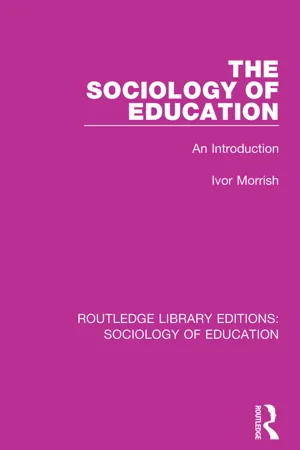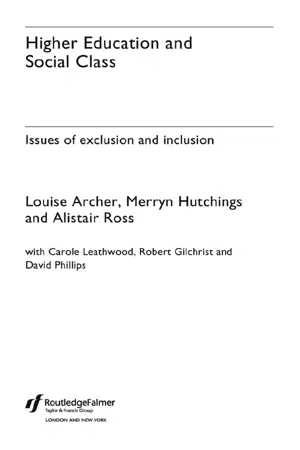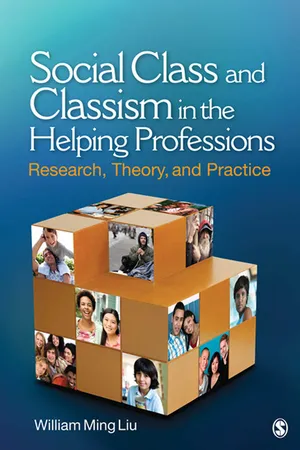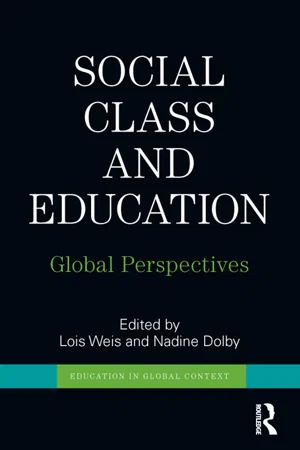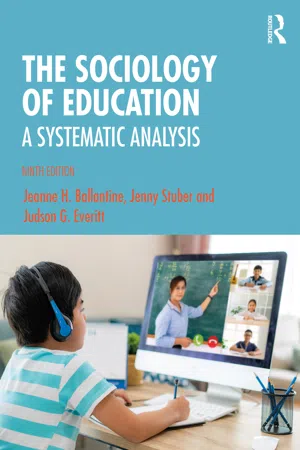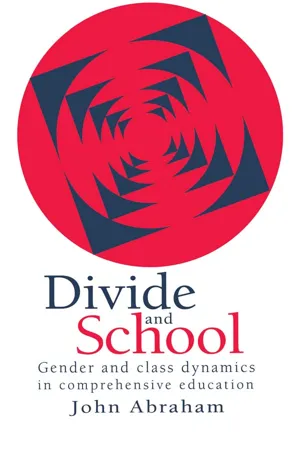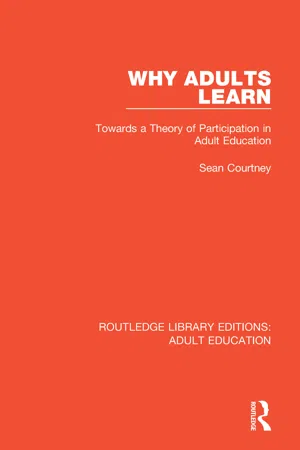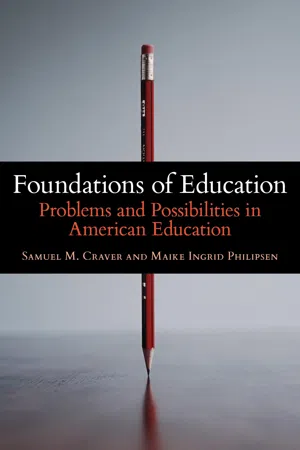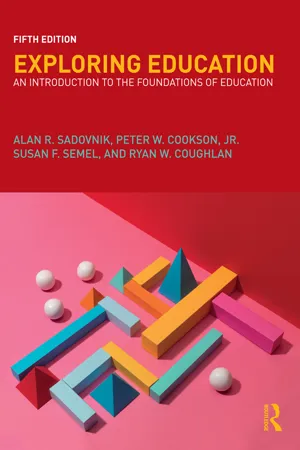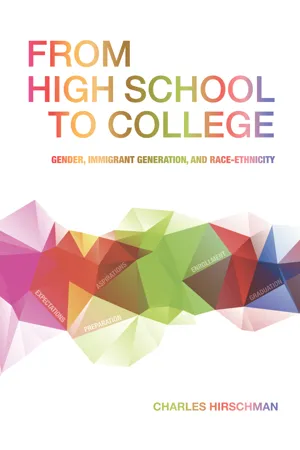Social Sciences
Social Class and Education
Social class and education refers to the relationship between an individual's socioeconomic status and their access to educational opportunities. It encompasses the impact of social and economic inequalities on educational attainment and outcomes. This area of study explores how social class influences educational experiences, resources, and achievement, and how it contributes to perpetuating or challenging social inequalities.
Written by Perlego with AI-assistance
Related key terms
Related key terms
1 of 4
Related key terms
1 of 3
12 Key excerpts on "Social Class and Education"
- eBook - ePub
The Sociology of Education
An Introduction
- Ivor Morrish(Author)
- 2019(Publication Date)
- Routledge(Publisher)
As we come to consider some of the relationships between social stratification and education we must bear in mind that, in all the variety of theories concerning class and group structure, certain vital facts emerge regarding such concepts as power, status, prestige, life chances, life-styles, patterns of consumption, leisure activities, and occupations. These are concrete facts amongst a considerable amount of abstract theorizing, and they are closely related to problems of culture, education and socialization. In all the ramifications of the literature on class and social groupings it is not easy for anyone, whether pundit or dilettante, to obtain any final and clear-cut view on social stratification. Human personality and development, whether considered in group or in individual terms, defies the strictly statistical analysis that so many seek in the sociology of the future.At least Dahrendorfs analysis recognizes the problem of the increasing number of 'classless' individuals who, as 'floating intellectuals', wander through the many areas of society, doing everything from working in sewers, singing pop-songs, producing or otherwise participating in TV shows, to lecturing in colleges and universities. But, no doubt, B. S. R. Green and E. A. Johns are right in their conclusion on the question of class:'While it may be agreed that socio-economic changes in our own society have largely invalidated the class conflict model, it must not be assumed that the concept of social class has been made irrelevant. The fact remains that people can be classified according to occupational prestige, income, education or other closely associated indicators of social status and that such classifications are not merely statistical categories but reflect differences in values, goals, attitudes and behaviours. For example, high social status is associated with greater political involvement, with more favourable attitudes towards further education and with a more rational mode of decision-making in such situations as occupational choice' (30) .D. Social Class and Education
In this section we are mainly concerned with the effects of social class or stratification upon education. In Chapter 8 - eBook - ePub
Higher Education and Social Class
Issues of Exclusion and Inclusion
- Louise Archer, Merryn Hutchings, Alistair Ross(Authors)
- 2005(Publication Date)
- Routledge(Publisher)
Chapter 1 Social class and higher education
Louise ArcherSocial class has long been a central theme within educational and sociological theorizing, research and analysis. Within sociology, Edgell (1993) has suggested that social class is ‘the most widely used concept’ although it has undergone fluctuating periods of being in turn either prioritized or dismissed as irrelevant. While the salience of social class may rise and fall within policy and academic discourses, surveys (for example Hudson and Williams 1989) have suggested that recent years have witnessed increases in the gap between broad sections of the population, whohave differential access tomoney, resources, qualifications, life chances and health. As will be outlined later in this chapter, education has always been centrally positioned within sociological theories of class re/production, playing an important role in ensuring either the reproduction of (middleclass) privileges or (working-class) disadvantages.Within educational research, issues of social class have been predominantly addressedinrelationtothe compulsory schooling context, where it has been noted that working-class children tend to experience persistently lower rates of attainment and are less likely to follow routes into post-compulsory education. For example, Bates and Riseborough (1993) detail how young people from different social classes do not attend the same types of educational institution, nor do they gain similar levels of qualifications and results, nor follow comparable post-16 routes. They argue that, at all stages within the educational journey, young working-class people experience poorer conditions, receive fewer resources, study for less prestigious qualifications and follow lower-status trajectories. As detailed in Chapters 2 and 3, concerns around class inequalities in access, retention and attainment within higher education have gained in importance in recent years. Internationally, the historical dominance of higher education by better-off socio-economic groups has also become a major cause for concern in the majority of industrialized countries. The intractability of this problem is evidenced by the relatively small changes in working-class participation rates following the mass expansion of higher education in Britain (see Chapters 2 and 3 - eBook - ePub
Social Class and Classism in the Helping Professions
Research, Theory, and Practice
- William Ming Liu(Author)
- 2010(Publication Date)
- SAGE Publications, Inc(Publisher)
Therefore, even with occupation, it seems that a simple matter of asking what a person does for a living and then putting a value or ranking on that job has variability depending on time and context. There are also assumptions built into occupations such as income level and educational experience, but these two variables that are supposed to correlate with occupation may not do so in the expected directions. Thus, the reader is likely becoming aware of the inherent problems that arise with asking these “objective” social class questions that tend to raise other pertinent questions.Education
Finally, education is a form of human capital that alludes to and measures obtusely the resources that were needed to obtain a particular level of education (Duncan & Magnuson, 2003). Thus, it is relevant to know how much education an individual has received, the progression of educational attainment, and where the person was educated. Assessing these facets is by no means an indication of the individual’s level of intelligence; rather it is an assessment of how an individual has been educated. Does the person have a history of private or public schools, were there preparatory schools, are there large gaps in the educational history, did the individual use financial aid, did the person work, was the person on scholarship, in what extracurricular activities did the individual participate (internships, externships), and is there graduate or professional education? All of these questions may translate to amount and type of monetary and other resources that were needed and used throughout the educational life of the individual. And all of these questions are not assessed by asking only, “What is your current education level?”Education is considered one of the most common indices of social class (Ensminger & Fothergill, 2003; Entwisle & Astone, 1994). But what does education confer to one’s social class? Research suggests that a person’s education level may be related to cultural tastes (Liberatos et al., 1988), how a child reads and speaks (Bornstein, Hahn, Suwalsky, & Haynes, 2003), and income (Ceci & Williams, 1997). Other research suggested that education reflects a person’s general mental ability (GMA) and that the higher one’s GMA, the more likely one would obtain higher levels of job training and prefer more complex jobs (Judge, Linger, & Simon, 2010). Hence, increasing educational experiences and where those educational experiences are gained may be related to a host of “educational” outcomes related to social class. - eBook - ePub
Social Class and Education
Global Perspectives
- Lois Weis, Nadine Dolby(Authors)
- 2012(Publication Date)
- Routledge(Publisher)
INTRODUCTION
Social Class and Education in Globalizing Context Lois Weis and Nadine Dolby DOI: 10.4324/9780203829202-1Within the past decade, increasing attention has been paid to issues of social class, reinvigorating a conversation that had waned by the close of the 20th century (Brantlinger, 2003 ; Burawoy, Chang, & Fei-yu Hsieh, 2010 ; Lareau, 2003 ; Massey & Denton, 1993 ; Patillo-McCoy, 2000 ; Reay, Crozier, & James, 2011 ; Torres, 2009 ; Walkerdine, Lucey, & Melody, 2001 ; Weis, 2004 , 2008 ). Class has reemerged in two ways. First, there is greater recognition of class as a key signifier of positionality (Lareau, 2003 ; Reay et al., 2011 ; Vincent & Ball, 2006 ; Walkerdine et al., 2001 ; Weis, 2004 , 2008 ) and second, there is deepening scholarly focus on entrenched and growing social and economic inequalities (Aron-Dine & Shapiro, 2006 ; Chauvel, 2010 ; Gilbert, 2003 ; Piketty & Saez, 2003 , 2006 ; Sherman & Aron-Dine, 2007 ).Social class, while perhaps a “phantasmatic” category, organizes the social, cultural, and material world in exceptionally powerful ways (Weis, 2004 , 2008 ). While class is clearly connected to income and occupation, and there is ample evidence that income inequalities are widening both within and between nations across the globe (Chauvel, 2010 ; Gilbert, 2003 ; Piketty & Saez, 2003 , 2006 ; Sherman & Aron-Dine, 2007 ), class must additionally be understood as practices of living—“the social and psychic practices through which ordinary people live, survive and cope” (Walkerdine et al., 2001 , p. 27). The books we read (or if we read at all); our travel destinations (if we have them and what they look like); the clothes we wear; the foods we eat; where and if our children go to school, how far and with what degree of success, with whom, and under what staff expectations and treatment; where and with whom we feel most comfortable; where we live and the nature of our housing; where and if we attend and complete postsecondary education, and under what expectations for success and imagined or taken for granted financing (parents, public/state/national/federal money, on or off campus job) are all profoundly - eBook - ePub
Diversities in Education
Effective ways to reach all learners
- David Mitchell(Author)
- 2016(Publication Date)
- Routledge(Publisher)
1In this chapter, I address four key questions relating to the OECD’s desire for equitable education systems, while also considering Dickens’s ‘furniture of their pockets’ and Matthew’s notion of the rich getting richer and the poor getting poorer:A What do we mean by social class/socio-economic status (hereafter SES)?B How do students from different SES backgrounds differ in educational achievement?C What causes SES differences?D How should education accommodate to any SES differences?A What do we mean by social class/socio-economic status?3.1 Definitions of social class/socio-economic status
Although they are often used interchangeably, the terms ‘social class’ and ‘socio-economic status’ (SES) refer to different concepts, with the former referring to one’s relatively stable socio-cultural background and the latter referring to one’s current social and economic situation and, consequently, being more changeable over time.2 More specifically, SES refers to an individual’s or family’s economic and social position in relation to others, based on income, education and occupation.3 Poverty forms a subset of SES and is usually, but not always, highly correlated with SES.Internationally, for the purposes of the PISA assessments of 15-year-old students, the OECD measures the socio-economic background of students from all participating countries, using an index of economic, social and cultural status. This index is based on students’ responses to questions about their family and home background, including their parents’ education and occupations and their home possessions, such as a desk to use for studying and the number of books in the home. Using this index, participating students are distributed into deciles of SES background representing a scale of relative disadvantage (bottom decile) through to relative advantage (top decile). It must be noted that the reliance on student reports on family background could lead to a considerable amount of measurement error, which needs to be taken into account when interpreting SES findings from PISA.4 - eBook - ePub
The Sociology of Education
A Systematic Analysis
- Jeanne Ballantine, Jenny Stuber, Judson Everitt(Authors)
- 2021(Publication Date)
- Routledge(Publisher)
The story of Caitlin and the other awardees raises an important question: Why do some people achieve greater educational success than others? For some, stories of such success illustrate the notion of the American Dream—the belief that individuals born in the United States have a unique opportunity to overcome the circumstances of their birth and achieve great things, regardless of their origins. Yet the fact that the title of this award is “Beat the Odds” serves as a potent reminder of just how unlikely it is that people will, in fact, defy the circumstances of their birth. When people “beat the odds,” they are, by definition, outliers: they defy statistical patterns showing that those who grow up in disadvantaged circumstances have a difficult time achieving educational success, while those who grow up in advantaged circumstances are more likely to do so. The very fact that they “beat the odds” means that the odds are stacked against them.On the one hand, many view the educational system as “the great equalizer”: the preeminent social institution in society where talent and hard work are rewarded; where individuals succeed or fail based on their own efforts, rather than their family background. On the other hand, many scholars challenge the idea that the educational system is a meritocratic institution; they argue that the educational system perpetuates social class inequalities: it reproduces the existing system of social stratification, rather than altering it.While educational inequalities exist with respect to race, class, and gender, those related to social class are the deepest and most enduring. School children enter school with different levels of abilities, and these achievements gaps persist throughout their educational journeys. In later years, social class gaps exist in terms of whether one goes to college (enrollment), where one goes (selectivity), and whether one graduates (attainment). In fact, college completion rates for the lowest-income groups have not increased in the last 40 years, despite massive expansion of the system of higher education. With respect to the open systems approach, the relevant question is whether students, as inputs, are fundamentally transformed as outputs by the educational system. This chapter provides answers to this question.To explore the relationship between social class stratification and educational inequalities, we take a sociological approach, combining an understanding of the micro- and macro-levels. At the micro-level, we assume that a student’s experiences in school reflect what that student brings to the game. This includes their intelligence and efforts, their primary socialization, their knowledge of how the educational system works, and—especially when it becomes time for higher education—access to financial resources. Still, every student navigates an educational system that has an established structure. Therefore, we expand our exploration of class inequalities in education by taking a look at the macro-level. Here, we show that the educational system does not operate in a class-neutral manner. Instead, students from advantaged backgrounds experience systematic advantages while those from less-advantaged backgrounds experience systematic barriers. - eBook - ePub
Divide And School
Gender And Class Dynamics In Comprehensive Education
- John Abraham(Author)
- 2014(Publication Date)
- Routledge(Publisher)
The frrst category includes Young's three dimensional model of the knowledge content of curricula and his general phenomenological theory focusing on how different social groups defme legitimate knowledge and, therefore, how school knowledge is determined. The first dimension is 'scope' (specialization), which defines the restriction of accessibility of knowledge areas to different groups of people. The second, openness, refers to the relatedness of certain knowledge areas. And the third, stratification, is a function of the power of some groups to define the social value of certain areas of knowledge. Young claims that all these dimensions can, and should, be explained by the sociology of education as part of a critical exploration into what counts as knowledge.Bernstein (1971) is the main contributor to the second category. He provides us with a plethora of concepts with which to study the social organization of formal educational knowledge. The two most important ones are classification, which refers to the degree of distinctiveness between contents, and framing, which refers to the degree of control teachers and pupils possess over the selection and pacing of the knowledge transmitted and received in· a pedagogical relationship. Classification is an especially useful idea to bear in mind when comparing educational practices in different subjects (or knowledge systems) whilst framing has obvious connections with organizational differentiation such as streaming versus mixed-ability classes.Under the third category fall two empirical studies carried out by Keddie (1971) and Anyon (1981). By comparing the actions of teachers as theorizers in the 'educationist context' and as practitioners in the classroom (the 'teacher context') Keddie showed how an 'undifferentiated' humanities curriculum package supported, in principle, by the teachers became differentiated, in practice, across different streams. Certain curriculum contents were deemed beyond the 'bottom' stream (mostly working-class). Their inability to cope with material considered appropriate for the 'top' stream (mainly middle-class) was often explained in terms of home background. The implication of Keddie's study is that school knowledge is differentiated on the basis of social class mediated by organizational factors such as streaming. Anyon's study was slightly different in that it postulated knowledge differentiation between working-class schools and middle-class schools. Anyon found that the school teachers had quite different expectations of what the pupils should know about in the different schools and used curriculum materials accordingly. Amongst the many sociological implications of this work is the contribution that a division of educational knowledge based on social class makes to the division of labour in the wider class society. - eBook - ePub
Why Adults Learn
Towards a Theory of Participation in Adult Education
- Sean Courtney(Author)
- 2018(Publication Date)
- Routledge(Publisher)
Some of this reaction is captured in Jencks and Riesman (1969), for whom an analysis of the impact of higher education on American society since the late 1800s was impossible ‘without talking about social stratification and class’ (p. 67). Within a strong statistical analysis, they demonstrated that if ‘social class’ was defined in terms of income and occupation (which in turn reflected the amount of power each group has or the amount of goods and services each consumes), then there had been little or no change in the size of the various social classes over a twenty-year period, from 1940 to 1960, and no real change in the distribution of income or concomitant power and prestige.The importance of this conclusion cannot be overemphasized, for it shapes our over-all analysis of the relationship between social class and higher education. If, for example, the size of the various classes is taken as fixed, social mobility must be treated as a two-way street. Upward mobility will be possible only if vacancies occur in higher strata for some reason (p. 72).At the same time, the education level of the general population has risen dramatically, especially since the Depression. If this is taken as a measure of ‘cultural class,’ it should be assumed that the upper cultural classes had expanded considerably since the Second World War. Again Jencks and Riesman found relative stability where they had expected dramatic change. They also found that despite the enormous progress in the spread of education to ever larger numbers of the general population, the ‘absolute gap between the best and worst educated third... widened from 5.8 to 7.0 years between the 1910-1914 generation and the 1930-34 generation, even though the distribution of schooling had grown more equitable’ (p. 83).Thus, it seemed, paradoxically, that the spread of mass higher education in the United States had been accompanied by the concentration of both economic and cultural status within certain groups, leading to the situation where ‘subcultures are more hierarchical than they used to be, and the “lower” tend to defer increasingly to the “higher”’ (p. 75). Despite the rise in the levels of income and education, and the more equitable distribution of both, the authors concluded cautiously, it seemed that the best paid men occupying the most prestigious jobs were also the best educated. ‘This suggests a considerable overlap in America’s economic, occupational and cultural elites’ (p. 86). Here we have a persuasive account which, if true, would explain the reason for overlapping populations with respect to the various forms of social participation analyzed in Chapter 5 - eBook - ePub
Foundations of Education
Problems and Possibilities in American Education
- Samuel M. Craver, Maike Ingrid Philipsen(Authors)
- 2011(Publication Date)
- Continuum(Publisher)
Social class fundamentally conditions a person’s options, or lack thereof. Furthermore, class impacts access to health care, child care, and numerous other services that affect the quality of life. Privilege tends to breed more privilege, which greatly improves opportunities and assistance should a privileged person encounter obstacles in life. Contrarily, poverty and material deprivation usually have a negative impact on people, limiting their access to adequate care, goods, services, and education. 52 Out-of-school factors (OFSs) are often directly related to school success, and class is indicative of many of those OFSs (for example, low birth weight, inad equate medical care, food insecurity, environmental pollutants, family stress, and neighborhood characteristics), any and all of which can significantly affect the learning opportunities of children. Indeed, poverty exacts a strong toll on communities, neighborhoods, families, and, therefore, schools and children. 53 In short, socioeconomic conditions shape life chances, a factual condition that has received inadequate attention in several leading school reform movements in the closing decades of the twentieth century and the beginning of the twenty-first century, a time characterized by policy shifts from concerns about equality of educational opportunity to concerns about school achievement as measured by test scores. It is difficult to capture a simple meaning of social class because it consists of many attributes. Class membership may be defined by income and financial assets, such as inherited wealth, property, and investments (or the lack thereof); it may also be defined by educational attainment and professional or occupational status. Class may be characterized by attributes difficult to measure, such as power, prestige, and tastes in style and language - eBook - ePub
Exploring Education
An Introduction to the Foundations of Education
- Alan R. Sadovnik, Peter Cookson, Jr., Susan Semel, Ryan Coughlan(Authors)
- 2017(Publication Date)
- Routledge(Publisher)
Socialization processes can shape children’s consciousness profoundly. Schools, for instance, wittingly or unwittingly, promote gender definitions and stereotypes when they segregate learning and extracurricular activities by gender, or when teachers allow boys to dominate class discussions and activities. Not only do schools shape students’ perceptions and consciousness but they also act as important, perhaps the most important, sorters and selectors of students. Schools, through such practices as tracking, academically stratify students by curricular placement, which, in turn, influences the long-term social, economic, and cultural destinies of children. In effect, schools play a major role in determining who will get ahead in society and who will not.How do schools select some students for educational mobility? Is it on the basis of merit or is it primarily on the basis of students’ ascriptive characteristics, such as class, race, or gender? Or is it a combination of merit and social position that explains who gets into the educational “fast track” and who gets “cooled out”? The concept of equal educational opportunity is a key element in the belief system that maintains that the United States is a land of opportunity where hard work is rewarded. Is this belief based on real social facts or is it simply a myth that confuses people and leads them to believe that their relative social and economic failure is caused by personal inadequacies?At an even deeper level, one might wonder why people study the subjects and materials they do. Who selects what people teach and learn, and why? Is knowledge value free or socially constructed? Can ideas ever be taken out of their contexts? For instance, history texts have traditionally overlooked the role of minorities and women in shaping U.S. society. How has this influenced people’s perceptions of what is really historically significant and what is not? Finally, how has education developed in other countries and has there been a global pattern of education (D. P. Baker, 2014)?Theoretical Perspectives
From these remarks, it should be apparent to you that the sociology of education is a contentious field and that the questions sociologists ask about the relation between school and society are fundamental and complex. Because the scope of these questions is so large, sociologists usually begin their studies with an overall picture of how society looks in its most basic form. This is where theory comes in. A good definition of theory - eBook - ePub
From High School to College
Gender, Immigrant Generation, and Race-Ethnicity
- Charles Hirschman(Author)
- 2016(Publication Date)
- Russell Sage Foundation(Publisher)
17The benefits of schooling are not limited to labor-market returns. A 2011 review of the nonpecuniary benefits of schooling with data from the NORC at the University of Chicago General Social Survey found that persons with higher levels of schooling enjoy advantages in health, happiness, family stability, and a broad array of social and psychological outcomes.18 Not all of the associations between schooling and positive outcomes are causal; other factors may be the joint determinant of both. However, most of the positive effects of schooling held up in multivariate models with statistical controls for socioeconomic background and other covariates.One of the strongest findings from recent research is that more highly educated people are healthier and live longer than persons with less schooling.19 In addition to a general association with SES and improved access to health care, education appears to be associated with a greater sense of control over behaviors and habits that contribute to health and longevity. Individuals with more education tend to smoke less, engage in fewer risky behaviors, experience less stress, exercise more, and have healthier diets.Highly educated women were once less likely to marry, but this tendency has reversed in recent decades. Since 1970, women, both white and African American, with college degrees have become more likely to marry and less likely to divorce.20 Cohabitation has become a normative feature of American family formation, but it is more prevalent among those with a high school diploma (or less) than among persons who have attended or graduated from college.21 These trends are accentuated by a growing social divide by educational attainment. Since 1970, college graduates have become much more likely to marry other college graduates than persons with lower educational attainments.22 These family-formation patterns have effects on the next generation. The children of less-educated parents are more likely to experience a parental divorce or have a parent with a cohabiting partner, or both.23 - eBook - ePub
Class Formation and Civil Society
The Politics of Education in Africa
- Patrick M. Boyle(Author)
- 2018(Publication Date)
- Routledge(Publisher)
4 Schooling and Social Stratification in Sub-Saharan AfricaIn most societies...it was perhaps the under-privileged who, predicting the future importance of education, took advantage of the new opportunities for status advancement and sent their children to school.1The promotion of formal education as the key variable supporting development virtually disappeared from the agendas of social scientists after the 1960s. The prominence of education in the modernization literature on the “new states” in independent Africa formed part of an overall development scheme for “raising the level of the population” in these states, but analysis of current realities soon replaced policy plans for an indeterminate future. Among political scientists, discussion of the role and formation of social classes in Sub-Saharan Africa in the 1970s paid relatively little attention to education, even in its relation to class.2 Except for assertions about the importance of certain schools in the formation of political elites, this literature has neglected to address the political significance of schooling3 for well over a decade. More recent studies on civil society contain relatively few references to schools or educational opportunity.4 The task of this chapter, therefore, is to situate these case studies on the development of formal education in Kinshasa, Yaoundé, and Nairobi within an appropriate scholarly context for their analysis and show the relevance of schooling to a new phenomenon, that is, the emergence of a class-based civil society in contemporary urban Africa.To accomplish this aim, I begin by examining the literature on the relationship between schooling and social stratification in Sub-Saharan Africa. Next, I discuss how the findings from these case studies, that is, the tendency for changes in schooling in these three cities either to promote the formation of social classes or reinforce existing class structures, are particularly suited to re-vitalizing scholarly debates about the formation of social classes and in challenging received notions about the emergence of civil society. The chapter concludes with a synthetic statement of my principal claim, namely, that formal schooling in urban Africa today plays an important role in a process of passive social differentiation between those with educational opportunities and those with none.
Index pages curate the most relevant extracts from our library of academic textbooks. They’ve been created using an in-house natural language model (NLM), each adding context and meaning to key research topics.
Explore more topic indexes
Explore more topic indexes
1 of 6
Explore more topic indexes
1 of 4
